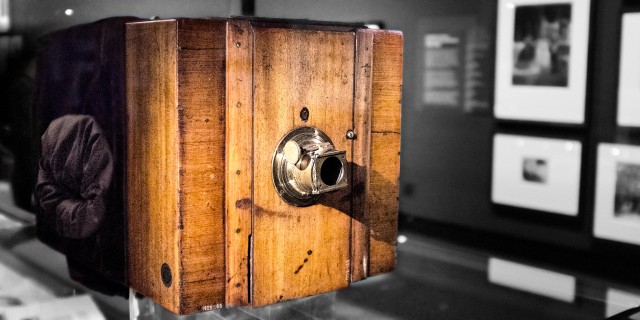The story (and science) behind your picture

Black and white
If your old photograph is black and white, or sepia, it is very likely to be a Gelatin Silver print.
In the Gelatin silver halide process, camera 'film' consists of a light-sensitive emulsion (a gelatin made of lots of light-sensitive silver halide crystals) on a base of plastic. When a photograph is taken, the crystals react to the light coming through the camera shutter, so that in the areas of the scene where there is light a reaction takes place, while in dark areas the crystals are unchanged. When the film is subsequently processed, the light-affected crystals react again to the developer solution to form black grains of silver. These black grains remain on the film, while another chemical (fixer) is applied to wash away the crystals that weren't exposed to light (the dark areas of the scene). The result is a 'negative' - a reverse image of the scene that was photographed, with the lightest areas of the photographed scene represented by the greatest density of black grains. To create the positive image that is needed, light is shone through the negative onto a special paper which (like film) is coated with light-sensitive silver compounds. This is your photographic print.
Gelatin silver halide was the basis of the methods later used for making colour photographs. But instead of one layer, several layers of emulsion were employed, with each emulsion recording a different colour.
Sepia
From the 1880s onwards photographers sometimes chose to give their black and white prints a 'tone' - for two main reasons: to make the picture look warmer, and/or to act as a preservative to prevent it from fading. Sepia toner converts the metallic silver in the print into silver sulfide, which is 50% more stable than silver and makes the print more resistant to pollutants in the atmosphere. In the process it gives the image a comfortable, yellow-brown hue.
Other tones were also used, sometimes to preserve, sometimes to add warmth, and sometimes to cancel out an unwanted colour tone produced by the printing process and provide a deep, rich black - the main purpose of selenium, which converts metallic silver to silver selenide. It was thought that selenium could also double the life of a print, but this is now questioned.
When your toned photograph is restored you can choose to retain the yellow-brown hue or have a picture that is black and white. Some prefer to keep the tone because they feel it is 'authentic'. Others argue that black and white is authentic, and that the tone might have been applied reluctantly by the photographer to keep the picture from fading. To complicate matters, many prints have yellowed over time because the photographic paper or gelatin matrix have changed colour with age (the silver particles making up the image are oxidising and causing the print to yellow and fade). So 'authenticity' means different things to each of us, and the decision to give your restored picture a 'hue' (or not) becomes a matter of taste and personal preference.
Colour
Whilst colour film didn't become available until the 1930s, pioneers had been experimenting with techniques for creating colour photographs for a long time before that. The first demonstration of the three-colour process that would become the foundation of almost all future colour techniques was in 1861. Using James Clerk Maxwell's method, three separate black and white photographs were taken and then projected through red, green and blue colour filters. Lumière Autochrome, the first commercially successful colour process, reached the market in 1907, but the required glass plates were expensive and exposure times long, making snapshots impossible. It wasn't until Kodak released Kodachrome film in the 1930s that colour photography (though still more expensive and less flexible than black and white) became more widely available and practical.
A correctly processed and stored black and white photograph (created using the silver halide method) is remarkably stable, shown by the huge number of old prints and negatives that survive. But colour photographs are, sadly, intrinsically unstable and much more vulnerable to light and fading. A colour picture's resilience depends on many factors, including the kind of inks and photographic paper that were used to make it, the type of light to which it has been exposed (ultraviolet radiation from sunlight is a particular problem), the intensity of the light and length of exposure to it, and the humidity and temperature of the display or storage environment. Older dye-based inks are invariably less resistant to sunlight and chemicals than 'pigment' inks, with the various dyes in a picture fading at different rates depending on how they were made. It is not uncommon for a photograph to have faded to its last surviving colour (red, blue, green or yellow); and eventually that final colour, with its remaining detail, will disappear, too.
The process of decay can be slowed by keeping colour photographs framed behind glass; this protects them from gasses in the air that cause fading (ozone, nitrogen oxide and sulphur oxide) - and away from bright light; an album with acid free pages is best for prolonging a picture's life. But while sunlight is a major problem for colour photographs, some will unfortunately fade even in the dark.
Digital photography - and photograph restoration done with computers - is hugely beneficial in this respect. Once a photograph has been restored and captured as a digital file, fading and decay cease to be problems because a fresh print can always be made.
If you have a treasured old photograph, contact Restoring Glory today to start out on your own amazing journey.




